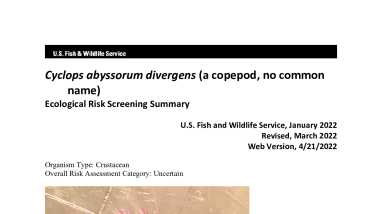Species that are considered uncertain risk need a more in-depth assessment beyond the Risk Summary to better define the species’ risk to U.S. environments.
Cyclops abyssorum divergens is a cyclopoid copepod with a native range that extends across southern and central Europe to southwest Asia. It has been introduced and become established outside of its native range in western Lake Erie in North America; impacts associated with this introduction are unknown. No trade history was found, and the State of Hawaii restricts private and commercial use of all species in the genus Cyclops. The history of invasiveness is Data Deficient. Substantial taxonomic uncertainty was identified during this assessment, with many sources identifying this species as C. divergens or other synonyms. The climate match for the contiguous United States was categorically high with the highest matches occurring in western States, the Midwest, Great Lakes basin, and portions of the Mid-Atlantic and Northeast. The certainty of this assessment is low due to a lack of biological information, taxonomic uncertainty, and unknown impacts of introduction. The overall risk assessment category for C. divergens is Uncertain.



